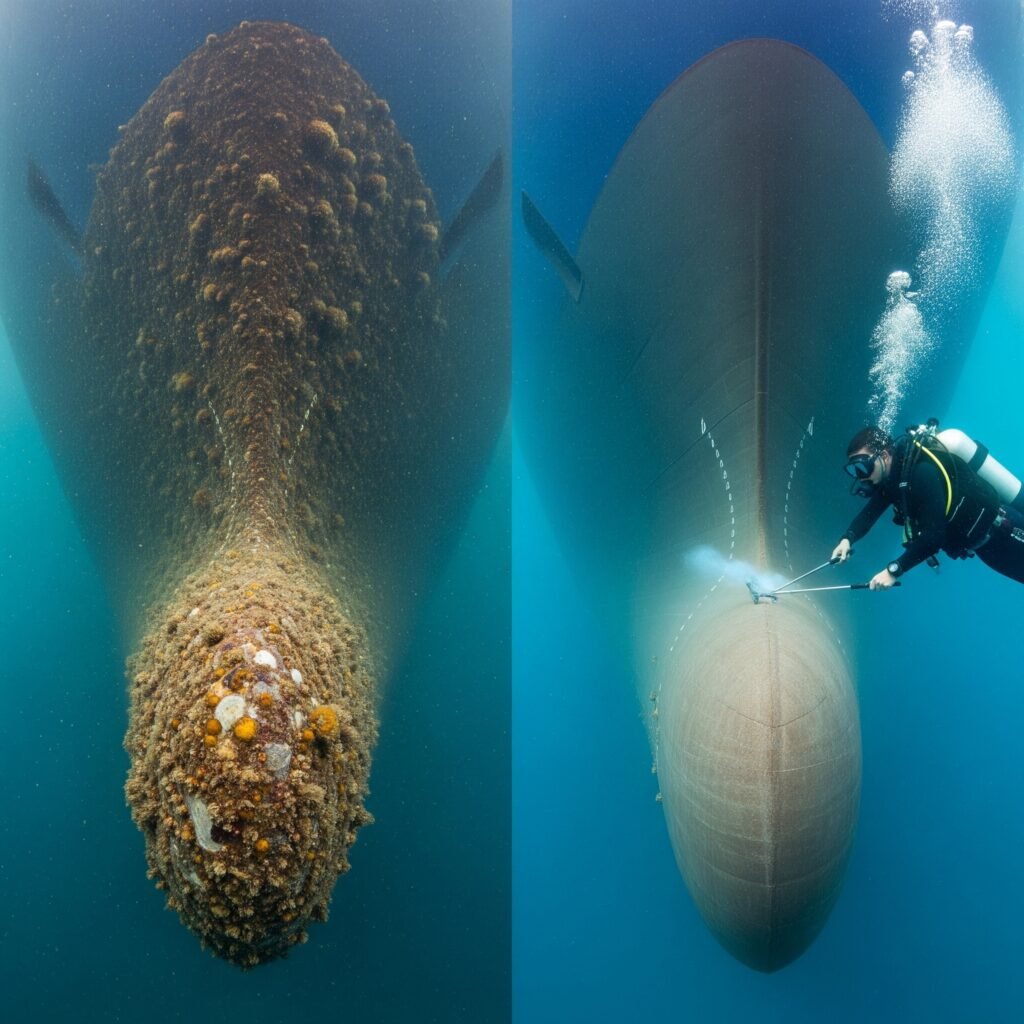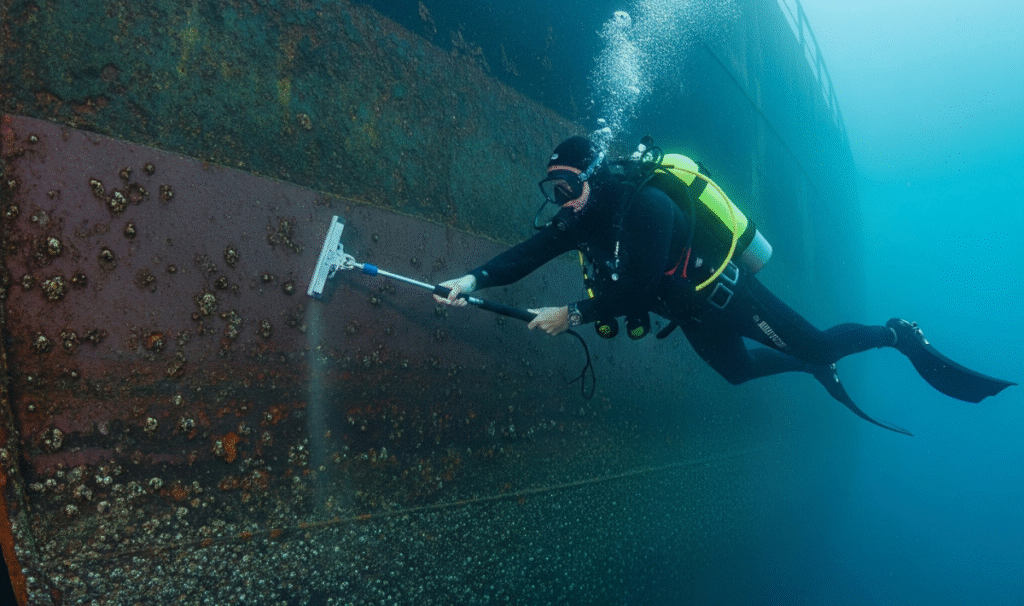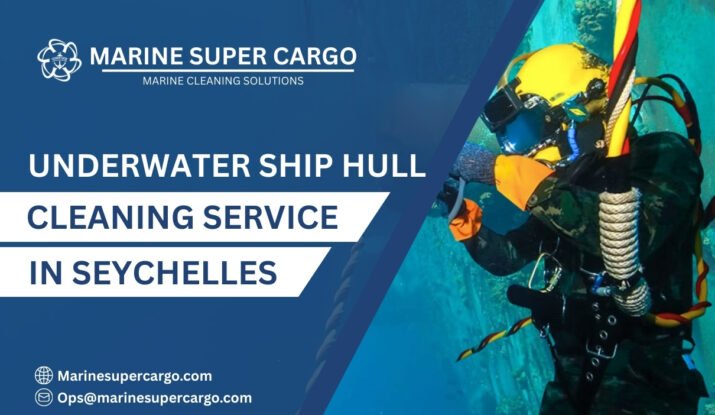When most people think of Seychelles, they imagine turquoise waters, white sandy beaches, and luxury resorts. But beyond its beauty, Seychelles is also a crucial maritime hub in the Indian Ocean. Located along key shipping corridors that connect Asia, Africa, and Europe, the archipelago’s waters see steady vessel traffic—from gigantic cargo ships to fuel tankers and fishing fleets.
Yet, beneath the ocean’s calm surface, a hidden challenge grows: biofouling, the build-up of algae, barnacles, and marine organisms that cling stubbornly to ship hulls. The solution? Underwater ship hull cleaning in Seychelles.
This isn’t just a routine wash—it’s a service with serious benefits. From cutting costs to extending ship health and protecting fragile marine ecosystems, hull cleaning is essential for modern vessels. Let’s explore the underwater ship hull cleaning in Seychelles.
What is Underwater Ship Hull Cleaning in Seychelles?
Think about a competitive swimmer. In a fresh, streamlined suit, they glide effortlessly through water. Now imagine that suit covered in weeds. Every stroke becomes a battle. That’s what ships experience with fouled hulls.
Underwater ship hull cleaning in Seychelles is carried out by trained divers or robotic machines who carefully scrub, brush, and suction marine growth from vessel hulls. The objective isn’t just cosmetic—it’s about optimizing performance, saving fuel, and meeting environmental regulations.
The Drag Effect of Biofouling
Even a thin film of algae can add resistance. Add barnacles and mussels, and ships sail as if dragging a heavy parachute through the water. Research shows fouling can increase drag by 30–40%, directly inflating fuel consumption.

The Financial Case for Clean Hulls
Regular underwater ship hull cleaning in Seychelles saves vessels enormous amounts of fuel. With bunker fuel being one of the largest operating expenses, a single cleaning can pay for itself within one voyage. Cleaner hulls also reduce voyage times, making trade routes through the Indian Ocean more efficient.
Preventing Corrosion and Hull Weakening
Marine organisms don’t just stick—they corrode. By holding seawater against steel, fouling accelerates rust and damages protective coatings. Left alone, this can lead to weakened hull structures.
Routine underwater ship hull cleaning in Seychelles prevents such risks, ensuring vessels remain strong, durable, and seaworthy for many years.
Inspection Readiness and Compliance
The International Maritime Organization (IMO) requires regular inspections, and hull fouling is a critical factor. Ships entering Seychelles’ waters, if heavily fouled, risk fines and costly operational disruptions. Cleaning ensures compliance and smooth passage, keeping vessels on schedule.
Cutting Emissions with Better Efficiency
Less drag equals less fuel burned. According to imo.org, the shipping industry is responsible for nearly 3% of all CO₂ emissions. By investing in underwater ship hull cleaning in Seychelles, ship operators directly cut their carbon impact.
Stopping the Spread of Invasive Species
The MARPOL Convention highlights invasive species as one of the biggest ecological threats. Fouled ships can transport barnacles, algae, and mussels across oceans, unintentionally introducing them to fragile marine ecosystems.
Routine hull cleaning in the Seychelles blocks this biological hitchhiking, protecting local coral reefs and marine biodiversity that the islands are world-famous for.
Strategic Maritime Stopover in the Indian Ocean
Nestled between Asia and Africa, Seychelles is a natural stopover for ships along global trade lanes. This makes underwater ship hull cleaning in Seychelles both convenient and efficient, reducing the need for detours.
Growing Infrastructure and Marine Expertise
Supported by best-practice frameworks from imca-int.com and iaphworldports.org, Seychelles is building capacity with trained divers and advanced port facilities. Ships receive professional, eco-compliant services that meet global standards.
How Hull Cleaning Works in the Seychelles
Step-by-Step Process
- Initial Inspection – Divers or ROVs assess fouling severity.
- Biofouling Removal – Brushes, high-pressure jets, or suction tools remove marine organisms.
- Polishing – Smooth finishes restored to minimize drag.
- Debris Collection – Waste captured to avoid polluting fragile reefs.
- Final Review – Reports provided for operational and regulatory compliance.
Tools and Modern Technology Used
Underwater ship hull cleaning in Seychelles increasingly uses robotic cleaners, suction-based debris capture systems, and eco-friendly brushes. These tools reduce risks for divers and prevent damage to hull coatings.
Challenges in Seychelles’ Waters
Fouling in Tropical Marine Conditions
The warm, nutrient-rich waters around Seychelles fuel rapid biofouling. Ships at anchor for just a few weeks can see significant marine growth. That makes regular underwater ship hull cleaning in Seychelles a necessity, not a choice.
Balancing Frequency and Costs
Clean too often, and coatings wear prematurely; wait too long, and fouling skyrockets. Experts recommend cleaning every 6–12 months, depending on ship type and routes.

The Future of Hull Cleaning in Seychelles
Eco-Friendly and Sustainable Innovations
The focus is shifting toward antifouling paints free from harmful biocides, and waste systems that prevent debris from re-entering the environment. Seychelles, known for its environmental stewardship, is well-positioned to adopt such practices.
AI and Robotics in Maritime Maintenance
Picture this: AI sensors monitoring hull smoothness in real-time, pinging alerts when fouling drags efficiency. Robots then carry out precision underwater ship hull cleaning in Seychelles autonomously. This future is closer than we think.
Conclusion
Beneath the surface of the turquoise Indian Ocean, fouling quietly chips away at shipping efficiency, costs, and environmental safety. But there’s a solution.
The 3 key benefits of underwater ship hull cleaning in Seychelles are:
- Fuel efficiency and cost savings that positively impact both profit and performance.
- Extended vessel life and safety, assuring compliance with international rules.
- Environmental protection, through emission cuts and the prevention of invasive species.
Ships passing through the Seychelles gain more than beautiful horizons—they get access to sustainable, efficient hull maintenance that benefits both business and the planet. With CleanShip.co, shipowners can rely on expert, eco-friendly services tailored to keep vessels compliant, efficient, and future-ready.
FAQ:
Q1. How often should underwater hull cleaning be done in Seychelles?
Typically, every 6–12 months, depending on biofouling rates and ship activity.
Q2. Does cleaning damage ship coatings?
Not if performed professionally. Modern eco-friendly tools protect coatings while removing fouling.
Q3. How does cleaning reduce emissions?
Less drag means less fuel burned, directly shrinking CO₂ emissions.
Q4. Why is Seychelles a hub for hull cleaning?
Its location along major trade lanes makes underwater ship hull cleaning in Seychelles convenient and strategic.
Q5. Can hull cleaning protect local marine biodiversity?
Yes. It prevents invasive species and helps preserve Seychelles’ coral reefs and unique ecosystems.


